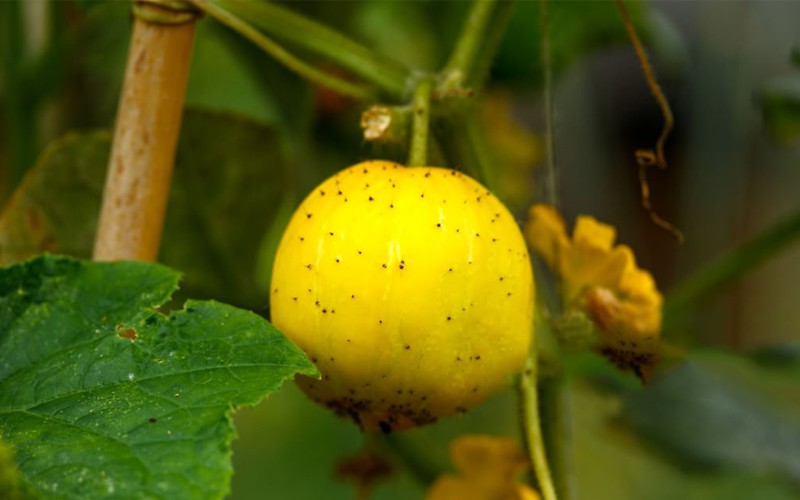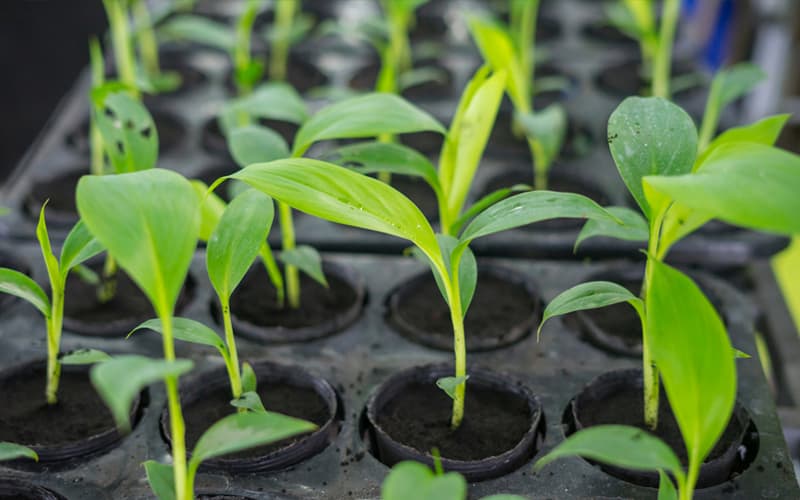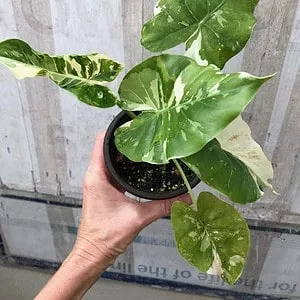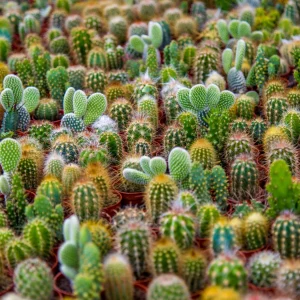No products in the cart.
Lemon cucumbers are a delightful addition to any garden with their vibrant yellow lemon hue and refreshing flavor to add to a salad.
These unique cucumbers offer a citrus flavor to the traditional cucumber, making them a favorite among gardeners and culinary enthusiasts.
Here, we give some valuable insights into the essential aspects of growing and caring for lemon cucumbers, ensuring a successful and rewarding gardening experience.
More About Lemon Cucumber Plants

Lemon cucumber plants, scientifically known as Cucumis sativus ‘Lemon,’ are annual vines from Central America. They are recognized for their vibrant yellow hue and have a lemon taste compared to the traditional green. They also have a sweet flavor. These cucumbers thrive in full sun and well-draining garden soil.
They exhibit rapid growth similar to a regular cucumber, reaching maturity in 55-65 days, and are suitable for container gardening in various USDA Hardiness Zones. Furthermore, they also attract beneficial insects to the garden.
You can also find them sold at ethnic Indian markets.
Plant Name: Cucumis sativus ‘Lemon’
Other Name: Crystal Apple Cucumber
Plant Type: Annual vine
Native Areas: Central America
Light Requirement: Full sun; at least 6-8 hours
Watering: Consistent moisture
Fertilizer: Balanced fertilizer
Toxicity: Non-toxic
Temperature: 70°F to 85°F
Propagation: Seeds
Growth: Fast-growing vine;
Soil Type: Well-draining soil, evenly moist
USDA Hardiness Zones: 4-11
More About Planting Lemon Cucumbers
Lemon cucumber plants should be planted outdoors after the danger of cold has passed and soil temperatures have warmed to at least 60°F.
Alternatively, start seeds indoors 3-4 weeks before the last expected frost to get a head start on the growing season.
Plant seeds 1 inch deep in well-draining soil, spacing them 12-24 inches apart in rows or hills to accommodate their sprawling growth habit.
-
$55.95Sold By: SunSoul Plants
$97.00In stock
Alocasia Odora ‘Variegata’ plant ‘Okinawa Silver’ in 3″ pot
Only 1 available and it’s in 2 people’s basketRated 4.87 out of 5 based on 98 customer ratings00Sold By: SunSoul Plants -
$40.00Sold By: NEEPA HUT
In stock
6″ Lipstick black pagoda + Striped Noir Planter Basket
Only 3 available and it’s in 3 people’s basketRated 4.99 out of 5 based on 221 customer ratings10Sold By: NEEPA HUT -
Free Shipping$8.96Sold By: CZ Grain
In stock
Cacti Seeds Mix – 50 Seeds – Cactus Species Mix – Ships from Iowa, USA – Grow Exotic Succulent Cacti
Only 900 available and it’s in 2 people’s basketRated 4.60 out of 5 based on 156 customer ratings00Sold By: CZ Grain -
$11.00Sold By: Cindi's Playground
In stock
Orange Daylily Ditch Lily
Only 2 available and it’s in 3 people’s basketRated 5.00 out of 5 based on 19 customer ratings04Sold By: Cindi's Playground
Quick Guide to Growing Lemon Cucumber Plants

Discover the essentials of cultivating vibrant lemon cucumber varieties with our Quick Guide to Growing Lemon Cucumbers ( Cucumis sativus ‘Lemon’ ).
This concise overview provides vital insights and actionable tips to help you nurture robust vines, ensuring a bountiful harvest of these refreshing, citrus-flavored cucumbers in your garden or containers.
Soil Preparation: Amend soil with compost or well-rotted manure to enrich nutrient content.
Watering: Maintain consistent moisture levels, avoiding waterloLemon Cucumbergged conditions.
Light: Provide direct light exposure for optimal growth and fruit production.
Fertilization: Apply a balanced fertilizer during planting and periodically throughout the season.
Support: Install trellises or stakes for vertical growth and to support heavy fruiting.
Lemon Cucumber Care
When it comes to growing lemon cucumbers, there are a few essential needs to consider as follows:
Soil and Water
The Lemon cucumber thrives in well-draining, fertile soil with a pH between 6.0 and 7.0. Regular watering is essential, particularly during dry spells, to keep the soil evenly moist, ensuring consistent moisture and preventing fruit bitterness. Hence, for outdoor plants, it helps to use a soaker hose.
Mulching around plants can further help retain soil moisture and regulate temperature fluctuations. Another notable thing is to grow lemon cucumbers up to 12-24 inches apart and provide space between rows around 3-4 feet as these are vigorous plants.
To save space, you can grow your food in containers or, if you have more space, in a raised bed.
Lighting Needs For Lemon Cucumber
Lemon cucumbers require full sunlight to thrive, receiving a minimum of 6-8 hours of direct sunlight daily. Adequate sunlight promotes robust growth, flowering, and fruit development, producing a more abundant harvest. They also work well as companion plants with other plants.
Temperature and Humidity
 lemon cucumber @meganhansen ( flickr )
lemon cucumber @meganhansen ( flickr )
These cucumbers prefer warm temperatures with less heat, ideally between 70°F and 85°F, to thrive and produce high-quality fruits. Maintaining moderate humidity levels and adequate airflow around plants can help prevent fungal diseases and promote overall plant health.
Fertilizer for Lemon Cucumber Plants
A balanced fertilizer applied during planting and monthly throughout the growing season can provide essential nutrients to support healthy growth and cucumber production. Avoid excessive nitrogen, as it can promote lush foliage at the expense of cucumber development.
Propagation of Lemon Cucumber
Compared to other cucumber varieties, the propagation is similar using the seeds and is a cost-effective method to expand them in the ground in your vegetable garden.
Seed Propagation:
Choose high-quality seeds from a reputable supplier or select seeds from mature, healthy fruits from your existing plants.
Start germinating seeds indoors 3-4 weeks before your region’s last expected frost date in spring. Use seed-starting trays or biodegradable pots filled with a quality seed-starting mix. It is a great way to grow lemon cucumbers in cooler climates.
Plant seeds approximately 1 inch deep in the soil, ensuring adequate spacing between seeds to prevent overcrowding once they germinate.
Keep the soil consistently moist but not soggy. Place the seed trays in a warm location with indirect sunlight or under grow lights to facilitate germination.
Once seedlings develop their second set of true leaves and all risk of cold has passed, transplant them into the garden, spacing them according to their mature size and growth habit.
Direct Sowing:
Alternatively, following the same spacing and depth guidelines as indoor planting, you can directly sow lemon cucumber seeds outdoors after the cold passes and the soil temperature warms up.
Tips for Successful Propagation:
Maintain a consistent temperature between 70°F and 85°F for optimal germination.
Ensure constant soil moisture throughout the germination and early growth stages to support healthy root development.
If seedlings are overcrowded, thin them to the strongest plants, maintaining the recommended spacing to avoid competition for nutrients and sunlight.
Potting and Repotting Lemon Cucumber
When growing lemon cucumbers in containers, choose a spacious pot with adequate drainage holes to accommodate their root system. Use a quality potting mix and repot plants to prevent overcrowding and ensure optimal growth. You can also grow lemon cucumber on a trellis for support, similar to growing outdoors.
Harvesting and Storing The Lemon Cucumber

Proper harvesting and storage of the cucumber are essential for maintaining their flavor, nutrition, and shelf life. Here’s a quick guide to help you enjoy the best of your cucumbers.
The lemon cucumber is ready for harvest when it reaches approximately 2-3 inches in diameter in late summer and displays a bright yellow color. The cucumber will be round, and the skin should feel firm, indicating maturity.
Use sharp scissors or pruning shears to cut the cucumber from the vine, ensuring a clean cut and minimizing damage to the plant.
Avoid pulling or twisting the cucumber, as this can damage the vine and reduce future yields. Harvest lemon cucumbers regularly, every 2-3 days, to encourage continued production and prevent over-ripening on the vine. When left for too long
Harvest in the morning when temperatures are cooler to minimize plant stress and ensure the cucumber is crisp and hydrated.
Store harvested cucumbers in the refrigerator in a perforated plastic bag or a damp paper towel to maintain freshness for up to a week to add to salads.
Worthy Note: Lemon cucumber has many health benefits in food and water.
To extend the shelf life of the cucumber, you can pickle them or freeze them after washing, slicing, and blanching.
Lemon Cucumber Pests and Troubleshooting

Regularly monitor plants for pests like aphids, cucumber beetles, and spider mites. Manage infestations with physical barriers, beneficial insects, and organic insecticides. Ensure good sanitation and crop rotation to prevent soilborne diseases and maintain plant vigor.
Frequently Asked Questions
Provide full sun, consistent moisture, and regular fertilization to support healthy growth and fruit production.
Lemon cucumbers thrive in direct light, receiving at least 6-8 hours of sunlight daily.
While lemon cucumbers are primarily self-pollinating, providing additional airflow or gentle shaking can enhance pollination and fruit set.
Water cucumbers deeply once or twice a week, ensuring the soil remains consistently moist but not waterlogged.
The cucumbers need a trellis for climbing. This keeps the cucumber off the ground, preventing rotting and maximizing garden space. Use a simple or elaborate trellis system to support the vines’.
Cucumbers can climb tomato cages with guidance, making it a versatile option for smaller gardens.
Whether you want to buy, sell, or reach out to other plant enthusiasts, Plantly is the right place to be!
-
$6.99Sold By: BubbleBlooms
In stock
Echeveria peacockii, desmetiana, white cloud in 3 inch pot, super filled
Rated 4.81 out of 5 based on 279 customer ratings00Sold By: BubbleBlooms -
$35.00Sold By: Helios Plants
$45.00In stock
Giant Lau Lau – Syzygium megacarpa – Giant Malay Apple
Only 5 available and it’s in 1 people’s basketRated 4.73 out of 5 based on 120 customer ratings00Sold By: Helios Plants -
$285.25Sold By: BONSAI WORLD LLC
Only 1 left in stock
Chinese Flowering White Serissa Bonsai Tree of a Thousand Stars
Sold By: BONSAI WORLD LLC -
$10.96Sold By: CZ Grain
In stock
20 Cocobolo Tree Seeds for Planting
Rated 4.60 out of 5 based on 156 customer ratings00Sold By: CZ Grain










